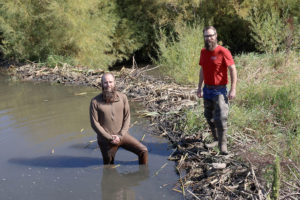ISU study focuses on how beaver dams impact water quality and quantity
February 17th, 2023 by Ric Hanson
(Radio Iowa) – Researchers at Iowa State University are studying beavers and the dams they build to determine what impact they may be having on the state’s fragile system of watersheds. The study’s name is the question they hope to answer — “Beavers: Superheroes for Water Quality?” Billy Beck, an I-S-U professor of natural resource ecology and management, says it’s still early in the three-year study, but they’re already starting to see some fascinating results. “We’re not really saying that they’re good or they’re bad at this point,” Beck says. “We just want to get some numbers on what exactly they’re doing for water quality and water quantity. For water quality, we’re looking at do they trap sediments and other nutrients behind the dam, which, nutrients can be problematic in excess, like phosphorus and nitrate.”
Beck, who’s also an I-S-U Extension and Outreach forestry specialist, says beavers were hunted to near-extinction in Iowa more than a century ago but have since rebounded. Some farmers and landowners may be annoyed by the nocturnal rodents because of the flooding caused by their dams. “Flooding is often thought of as a bad thing, but when rivers flood, a lot of good things happen for water quality and water quantity,” Beck says. “There’s a lot of nutrient deposition on our floodplains that goes into long-term storage. It’s a huge sponge that soaks up that flood velocity, preventing excessive downstream flooding.”

ISU Prof. Billy Beck (right) and grad student Andrew Rupiper at a beaver dam study site. (IA Learning Farms photo)
Beavers rarely just build one dam, it’s usually a whole string of dams, so Beck says they’re carefully testing the water in multiple areas. “We’re taking water quality samples from above, we’re checking water quality at a series of places throughout the dam chain, and then finally at the end of the chain,” Beck says. “We’re sampling those for nitrogen or nitrate, phosphorus, sediments, and then things like dissolved oxygen and temperature, things like that.” Early findings indicate that nitrate levels are being reduced by beaver dam chains at the rate of one-to-two parts per million. “Which doesn’t sound like a lot, but if you factor in all the water that runs through there and multiply that by the concentration, that’s a lot of pounds of nitrates that are being removed in that dam system,” Beck says. “Then, comparing that to an equal length of non-dammed stream, that’s a big reduction in that short of a time.”
The study, supported by the Iowa Nutrient Research Center, is looking at beaver dams in north-central Iowa, including along Prairie Creek near Fort Dodge and along Caton Branch, near Woodward. Beck says there’s been much more study in the Pacific Northwest of beavers and their impacts, especially on fish populations, but little is known about them in the agricultural landscape of Iowa.





